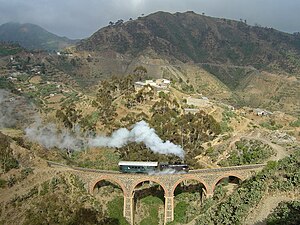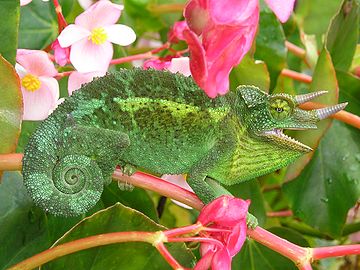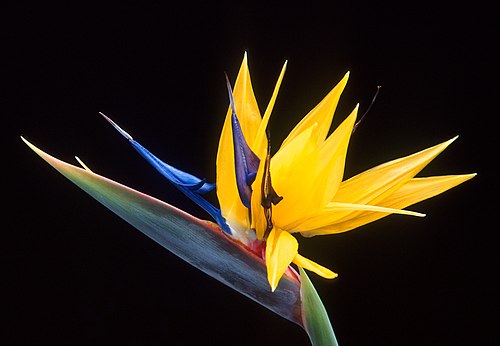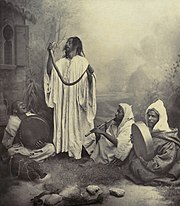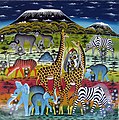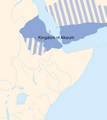Portal:Africa

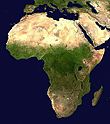

Africa is the world's second-largest and second-most populous continent after Asia. At about 30.3 million km2 (11.7 million square miles) including adjacent islands, it covers 20% of Earth's land area and 6% of its total surface area. With nearly 1.4 billion people as of 2021, it accounts for about 18% of the world's human population. Africa's population is the youngest among all the continents; the median age in 2012 was 19.7, when the worldwide median age was 30.4. Based on 2024 projections, Africa's population will reach 3.8 billion people by 2099. Africa is the least wealthy inhabited continent per capita and second-least wealthy by total wealth, ahead of Oceania. Scholars have attributed this to different factors including geography, climate, corruption, colonialism, the Cold War, and neocolonialism. Despite this low concentration of wealth, recent economic expansion and a large and young population make Africa an important economic market in the broader global context. Africa has a large quantity of natural resources and food resources, including diamonds, sugar, salt, gold, iron, cobalt, uranium, copper, bauxite, silver, petroleum, natural gas, cocoa beans, and.
Africa straddles the equator and the prime meridian. It is the only continent to stretch from the northern temperate to the southern temperate zones. The majority of the continent and its countries are in the Northern Hemisphere, with a substantial portion and a number of countries in the Southern Hemisphere. Most of the continent lies in the tropics, except for a large part of Western Sahara, Algeria, Libya and Egypt, the northern tip of Mauritania, and the entire territories of Morocco and Tunisia, which in turn are located above the tropic of Cancer, in the northern temperate zone. In the other extreme of the continent, southern Namibia, southern Botswana, great parts of South Africa, the entire territories of Lesotho and Eswatini and the southern tips of Mozambique and Madagascar are located below the tropic of Capricorn, in the southern temperate zone.
Africa is highly biodiverse; it is the continent with the largest number of megafauna species, as it was least affected by the extinction of the Pleistocene megafauna. However, Africa also is heavily affected by a wide range of environmental issues, including desertification, deforestation, water scarcity, and pollution. These entrenched environmental concerns are expected to worsen as climate change impacts Africa. The UN Intergovernmental Panel on Climate Change has identified Africa as the continent most vulnerable to climate change.
The history of Africa is long, complex, and varied, and has often been under-appreciated by the global historical community. In African societies the oral word is revered, and they have generally recorded their history via oral tradition, which has led anthropologists to term them oral civilisations, contrasted with literate civilisations which pride the written word. During the colonial period, oral sources were deprecated by European historians, which gave them the impression Africa had no recorded history. African historiography became organized at the academic level in the mid-20th century, and saw a movement towards utilising oral sources in a multidisciplinary approach, culminating in the General History of Africa, edited by specialists from across the continent. (Full article...)
Selected article –
The siege of Saïo or battle of Saïo took place during the East African Campaign of World War II. Belgo-Congolese troops, British Commonwealth forces and local resistance fighters besieged the fort at the market town of Saïo in south-western Ethiopia in 1941. The siege lasted for several months, culminating in an Allied attack on the Italian garrison thereby forcing it to surrender.
In the first months of 1941, British and Belgian colonial forces attacked Italian East Africa from the colony of Anglo-Egyptian Sudan. By the end of March, they had seized the town of Gambela and begun containing retreating Italian forces, which were massing on a plateau in the mountain town of Saïo (presently Dembidolo) under the command of General Carlo De Simone and later General Pietro Gazzera. The British forces withdrew the following month (to start an offensive in Western Ethiopia) and the Belgians advanced down the road to Saïo. The Italians repelled them and they were forced to hold their positions along a nearby brook. Almost no fighting took place in May as heavy rain bogged down the Belgians and turned their supply line from Sudan into mud, creating a food shortage. In early June, reinforcements arrived via river and the Belgians besieged the Italian supply depot at Mogi. Aggressive patrols, combined with the actions of the Ethiopian resistance and raids from the South African Air Force put increased pressure upon the Italian garrison. (Full article...)
Featured pictures –
Did you know (auto-generated) -

- ... that the pulse stops during the soliloquy of In C Mali?
- ... that South African civil rights activist Thambi Naidoo was arrested along with Mahatma Gandhi and sent outside of Transvaal for refusing to register?
- ... that Albert Luthuli was the first African to win the Nobel Peace Prize?
- ... that after the 1999 Tempe military base shooting, the Pan African Congress demanded a military funeral for the perpetrator?
- ... that land for a library built for African Americans in Virginia was donated by Pope Pius XII?
- ... that Jérôme Chappellaz wants to collect ice cores from Africa's Mount Kilimanjaro to be preserved in Antarctica?
Categories
Selected biography –
Amanirenas (also spelled Amanirena), was queen regnant of the Kingdom of Kush from the end of the 1st century BCE to beginning of the 1st century CE. She is known for invading Roman occupied Egypt and successfully negotiating the end of Roman retaliation, retaining Kushite independence.
Her full title was Amnirense qore li kdwe li ("Ameniras, qore and kandake"). Meroitic, the indigenous language of the kingdom of Kush, remains undeciphered; however, inscriptions giving Queen Amanirenas the title of "qore" as well as "kandake" suggest that she was an individually ruling queen. (Full article...)
Selected country –
 |
 |
||
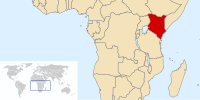
| |||
Kenya, officially the Republic of Kenya, is a country in Eastern Africa. It is bordered by Ethiopia to the north, Somalia to the northeast, Tanzania to the south, Uganda to the west, and Sudan to the northwest, with the Indian Ocean to the southeast. At 224,961 mi² (582,646 km²), Kenya is the world's forty-seventh largest country. Mount Kenya, which reaches 5,199 meters (17,057 ft), is the highest point in Kenya and the second highest in Africa.
Nairobi, the capital, is the primary communication and financial hub of East Africa. It enjoys the region's best transportation linkages, communications infrastructure, and trained personnel, although these advantages are less prominent than in past years. A wide range of foreign firms maintain regional branches or representative offices in the city. In March 1996, the Presidents of Kenya, Tanzania, and Uganda re-established the East African Community (EAC). The EAC's objectives include harmonizing tariffs and customs regimes, free movement of people, and improving regional infrastructures. In March 2004, the three East African countries signed a Customs Union Agreement. (Read more...)
Selected city –
Gqeberha (English: /kɛˈbɛərxə/ keb-AIR-khə, Xhosa: [ᶢǃʱɛ̀ɓéːxà]), formerly known as Port Elizabeth and colloquially referred to as P.E., is a major seaport and the most populous city in the Eastern Cape province of South Africa. It is the seat of the Nelson Mandela Bay Metropolitan Municipality, South Africa's second-smallest metropolitan municipality by area. It is the sixth-most populous city in South Africa and is the cultural, economic and financial hub of the Eastern Cape.
Gqeberha was founded in 1820 as Port Elizabeth by Sir Rufane Donkin, who was the governor of the Cape at the time. He named it after his wife, Elizabeth, who had died in India. The Donkin Memorial in the CBD of the city bears testament to this. It was established by the government of the Cape Colony when 4,000 British colonists settled in Algoa Bay to strengthen the border region between the Cape Colony and the Xhosa. It is nicknamed "The Friendly City" or "The Windy City". In 2019, the Eastern Cape Geographical Names Committee recommended that Port Elizabeth be renamed Gqeberha, after the Xhosa and Southern Khoe name for the Baakens River that flows through the city. The city's name change was officially gazetted on 23 February 2021. (Full article...)
In the news
- 12 February 2024 –
- Two boats collide on the Congo River near Kinshasa, Democratic Republic of the Congo; with the death toll remains unclear. (AP)
- 11 February 2024 – 2023 Africa Cup of Nations
- In association football, hosts Ivory Coast win their third Africa Cup of Nations by defeating Nigeria 2–1 in the final. Sébastien Haller scores the winning goal in the 81st minute. (The Guardian)
- 10 February 2024 – Somali civil war
- Four Emirati soldiers and a Bahraini military officer are killed, while ten other people are injured, when a soldier opens fire at a military base in Mogadishu, Somalia, before being killed in the ensuing shootout. Al-Shabaab claims responsibility. (AP)
- 10 February 2024 –
- A Eurocopter EC130 helicopter crashes near Nipton, California, United States, killing all the six people on board, including Nigerian banker Herbert Wigwe. (CBS News)
- 10 February 2024 – 2023–2024 Senegalese protests
- Violent protests occur in Senegal following an announcement by President Macky Sall that presidential elections have been delayed from February 25 to December 15. (Sky News)
- 9 February 2024 –
- At least 18 people are killed during a collision between a bus and a truck on a road in Kinshasa, Democratic Republic of the Congo. (AP)
Updated: 16:33, 14 February 2024
General images -
Africa topics
More did you know –
- ...that from 1926 to 1940, the Union Minière du Haut Katanga had a virtual monopoly of the world uranium market?
- ...that Anfillo is an endangered language of Western Ethiopia, spoken only by a few hundred adults above sixty?
- ...that Bono Manso, the capital of Bono state, was an ancient Akan trading town in present-day Ghana, which was frequented by caravans from Djenné as part of the Trans-Saharan trade?
- ...that Reverend John Chilembwe is celebrated as the first Malawian nationalist, and was a martyr for his cause?
Related portals
Major Religions in Africa
North Africa
West Africa
Central Africa
East Africa
Southern Africa
Associated Wikimedia
The following Wikimedia Foundation sister projects provide more on this subject:
-
Commons
Free media repository -
Wikibooks
Free textbooks and manuals -
Wikidata
Free knowledge base -
Wikinews
Free-content news -
Wikiquote
Collection of quotations -
Wikisource
Free-content library -
Wikispecies
Directory of species -
Wikiversity
Free learning tools -
Wikivoyage
Free travel guide -
Wiktionary
Dictionary and thesaurus



